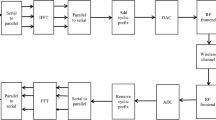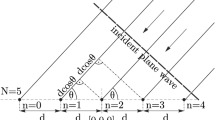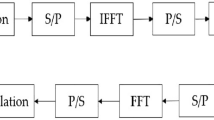Abstract
A telecommunication system uses carriers in order to transmit information through a cable or wirelessly. If each time only one carrier is transmitted, then the system’s signal will not be immune to frequency selective fading. If frequency selective fading includes the working frequency of the system, then the wireless link will not be established. Orthogonal frequency division multiplexing (OFDM) is the primary solution for coping with inter-signal interference and frequency-selective fading. Many carriers can be produced by splitting a fast information stream to slower data series. Different orthogonal frequencies carry slower data series. System’s performance can be further enhanced with the utilization of turbo codes. Turbo codes make the system more immune to noise effects with excellent BER results. This paper presents the thorough analysis of a turbo coded OFDM scheme using a PCCC technique in the presence of a channel which includes AWGN, phase noise, Rayleigh fading, Rician fading and Doppler shift.











Similar content being viewed by others
References
Marchetti, N., Rahman, M. I., Kumar, S., & Prasad, R. (2009). OFDM: Principles and challenges. In New directions in wireless communications research (pp. 29–62). Springer.
Van Nee, R., Jones, V. K., Awater, G., Van Zelst, A., Gardner, J., & Steele, G. (2006). The 802.11n MIMO-OFDM standard for wireless LAN and beyond. Wireless Personal Communications, 37, 445–453.
Pfletschinger, S., & Sanzi, F. (2004). Iterative demapping for OFDM with zero-padding or cyclic prefix. In Proceedings of the IEEE international conference on communications (ICC) (pp. 842–846). Paris. June 20–24, 2004. doi:10.1109/ICC.2004.1312620.
Muquet, B., Wang, Z., Giannakis, G. B., De Courville, M., & Duhamel, P. (2002). Cyclic prefixing or zero padding for wireless multicarrier transmissions? IEEE Transactions on Communications, 50(12), 2136–2148. doi:10.1109/TCOMM.2002.806518.
Van Nee, R., Awater, G., Morikura, M., Takanashi, H., Webster, M., & Halford, K. W. (1999). New high-rate wireless LAN standards. IEEE Communications Magazine, 37(12), 82–88. doi:10.1109/35.809389.
Tatsis, G., Votis, C., Raptis, V., Christofilakis, V., Chronopoulos, S. K., & Kostarakis, P. (2009). Performance of UWB-impulse radio receiver based on matched filter implementation with imperfect channel estimation. In Proceedings of the 7th international conference of the balkan physical union, American Institute of Physics Conference Series (Vol. 1203, pp. 573–578). Alexandroupolis, September 9–13, 2009.
Tatsis, G., Christofilakis, V, Votis, C., Chronopoulos, S. K., & Kostarakis, P. Experimental measurements of UWB channel. In Proceedings of the 2nd Pan-Hellenic Conference on Electronics and Telecommunications—PACET’12. Organized by the Electronics and the Telecommunications laboratories of the Departments of Physics and Electrical and Computer Engineering, of the Aristotle University of Thessaloniki (AUTh), Greece.
Raptis, V., Tatsis, G., Chronopoulos, S. K., Mallios, S., & Kostarakis, P. (2013). Development and experimental measurements of a tunable antenna. Communications and Network, 5(3), 220–224.
Chronopoulos, S. K., Tatsis, G., & Kostarakis, P. (2011). Turbo codes: A new PCCC design. Communications and Network, 3(4), 229–234. doi:10.4236/cn.2011.34027.
Chronopoulos, S. K., Votis, C., Raptis, V., Tatsis, G., & Kostarakis, P. (2009). In depth analysis of noise effects in orthogonal frequency division multiplexing systems, utilising a large number of subcarriers. In Proceedings of the 7th international conference of the Balkan Physical Union (pp. 967–972). Alexandroupolis. September 9–13, 2009. doi:10.1063/1.3322592.
Chronopoulos, S. K., Tatsis, G., & Kostarakis, P. (2012). Turbo coded OFDM with large number of subcarriers. Journal of Signal and Information Processing (JSIP), 3(2), 161–168. doi:10.4236/jsip.2012.32021.
Chronopoulos, S. K., Tatsis, G., Raptis, V., & Kostarakis, P. (2011). Enhanced PAPR in OFDM without deteriorating BER performance. International Journal of Communications, Network and System Sciences, 4(3), 164–169. doi:10.4236/ijcns.2011.43020.
Chronopoulos, S. K., Christofilakis, V., Tatsis, G., & Kostarakis, P. (2012). Reducing peak-to-average power ratio of a turbo coded OFDM. Wireless Engineering and Technology, 3(4), 195–202. doi:10.4236/wet.2012.34028.
3rd Generation Partnership Project 3GPP and Technical Specification Group Radio Access Network, “High Speed Downlink Packet Access: UE Radio Transmission and Reception,” Technical Report 3GPP TR 25.890 V1.0.0, May 2002.
Miranda, A. M. J., & Smulders, P. F. M. (2003). Performance of QPSK OFDM with and without channel/frequency offset estimation and equalization, and study of the interference cause by RF Impairments. Final Project—ERASMUS PROGRAM, Eindhoven University of Technology, July 2003.
Schulze, H., & Luders, C. (2005). Theory and applications of OFDM and CDMA wideband wireless communications. UK: Wiley.
Fuertes, L. Z. (2005). OFDM PHY layer implementation based on the 802.11a standard and system performance analysis. B.Sc. Thesis, University of Linkoping, Linkoping.
Shooshtary, S. (2008). Development of a MATLAB simulation environment for vehicle-to-vehicle and infrastructure communication based on IEEE 802.11p. M.Sc. Thesis, Vienna University of Technology, Vienna.
Prot, S., & Palmkvist, K. (2003). TSTE91 system design communications system simulation using Simulink Part V OFDM by IFFT modulation. Electronic Systems, Dept. EE, LiTH.
Xie, W., Hu, G.-J., & Deng, Q. (2008). Application of turbo codes in optical OFDM multimode fiber communication system. Optics Communications, 281(5), 1118–1122. doi:10.1016/j.optcom.2007.10.84.
Chronopoulos, S. K., Tatsis, G., Raptis, V., & Kostarakis, P. A parallel turbo encoder-decoder scheme. In 2nd Pan-Hellenic conference on electronics and telecommunications—PACET’12. Organized by the Electronics and the Telecommunications laboratories of the Departments of Physics and Electrical and Computer Engineering, of the Aristotle University of Thessaloniki (AUTh), Greece.
Raad, I. S., & Yakan, M. (2005). Implementation of a turbo codes test bed in the simulink environment. In Proceedings of the eighth international symposium on signal processing and its applications ISSPA’05 (pp. 847–850). IEEE: Sydney, August 28–31, 2005. doi:10.1109/ISSPA.2005.1581071.
Jain, R. (2007). Channel models a tutorial V1.0. In CSE574S: Wireless and mobile networking. Washington University in St. Louis. www.cse.wustl.edu/~jain/cse574-08/ftp/channel_model_tutorial.pdf.
Proakis, J. G. (2001). Digital communications (4th ed.). New York: McGraw-Hill.
Tse, D., & Viswanath, P. (2005). Fundamentals of wireless communication. Cambridge: Cambridge University Press.
Gupta, M., Nema, R., Mishra, R. S., & Guran, P. (2011). Performance analysis of OFDM system using MLSE equalizer over Rayleigh fading channel with different modulation technique. International Journal of Electronics Communication and Computer Engineering (IJECCE), 2(2), 22–26.
Mini-Circuits, “Characterizing and minimizing VCO phase noise,” Application Note VCO15-6, 1999. http://www.minicircuits.com/pages/app_notes.html.
Zhang, L. (2005). A study of IEEE 802.16a OFDM-PHY baseband. M.Sc. Thesis, Linkoping Institute of Technology, Linkoping.
Cooper, M. A., Armour, S. M. D., & McGeehan, J. P. (2003). Downlink performance and complexity evaluation of equalisation strategies for an MC-CDMA ‘4G’ physical layer candidate. In Proceedings of the IEEE Benelux chapter on communications and vehicular technology. IEEE: Eindhoven.
Mohamedian, M. A., Abdelrahman, I. A. M., Eldin, I., & Osman, M. (2007). Performance of orthogonal frequency division multiplexing (OFDM) under the effect of wireless transmission system drawbacks. Sudan Engineering Society Journal, 53(49), 17–26.
Khalidin, Z. B., & Taha, H. J. (2010). Performance of orthogonal frequency division multiplexing system based on mobile velocity and subcarrier. Journal of Computer Science, 6(2), 194–198.
Roca, A. (2007). Implementation of a WiMAX simulator in Simulink. Diploma Thesis, Engineering Institute-Vienna.
Soma, P., Baum, D. S., Erceg, V., Krishnamoorthy, R., & Paulraj, A. J. (2002). Analysis and modeling of multiple-input multiple-output (MIMO) radio channel based on outdoor measurements conducted at 2.5 GHz for fixed BWA applications. In Proceedings of the IEEE international conference on communications, ICC. IEEE (Vol. 1, pp. 272–276).
Omote, H., Ohta, Y., & Fujii, T. (2009). Predicting the K-factor of divided paths in wideband mobile propagation. In Proceedings of the 69th IEEE vehicular technology conference, VTC Spring 2009 (pp. 1–5). IEEE.
Kasdin, N. J. (1995). Discrete simulation of colored noise and stochastic processes and l/fα power law noise generation. Proceedings of the IEEE, 83(5), 802–827.
Ye, C., Reznik, A., Sternberg, G., & Shah, Y. (2007). On the secrecy capabilities of ITU channels. In Proceedings of the 66th IEEE vehicular technology conference VTC-2007 (pp. 2030–2034). IEEE. doi:10.1109/VETECF.2007.426.
Clarke, R. H., & Khoo, W. L. (1997). 3-D mobile radio channel statistics. IEEE Transactions on Vehicular Technology, 46(3), 798–799.
Messier, G. G., & Hartwell, J. A. (2009). An empirical model for nonstationary ricean fading. IEEE Transactions on Vehicular Technology, IEEE, 58(1), 14–20.
Ziri-Castro, K. I., Evans, N. E., & Scanlon, W. G. (2006). Propagation modelling and measurements in a populated indoor environment at 5.2 GHz. Proceedings of the AusWireless, 2006(13–16), 1–8.
Zheng, J., Peng, S., Zhu, G., & Wang, H. (2013). Fast synchronization and channel estimation for OFDM systems. Wireless Personal Communications, 69, 1207–1222.
Acknowledgments
This research has been co-financed by the European Union (European Social Fund—ESF) and Greek national funds through the Operational Program “Education and Lifelong Learning” of the National Strategic Reference Framework (NSRF)—Research Funding Program: Heracleitus II. Investing in knowledge society through the European Social Fund.
Author information
Authors and Affiliations
Corresponding author
Rights and permissions
About this article
Cite this article
Chronopoulos, S.K., Christofilakis, V., Tatsis, G. et al. Performance of Turbo Coded OFDM Under the Presence of Various Noise Types. Wireless Pers Commun 87, 1319–1336 (2016). https://doi.org/10.1007/s11277-015-3055-1
Published:
Issue Date:
DOI: https://doi.org/10.1007/s11277-015-3055-1




